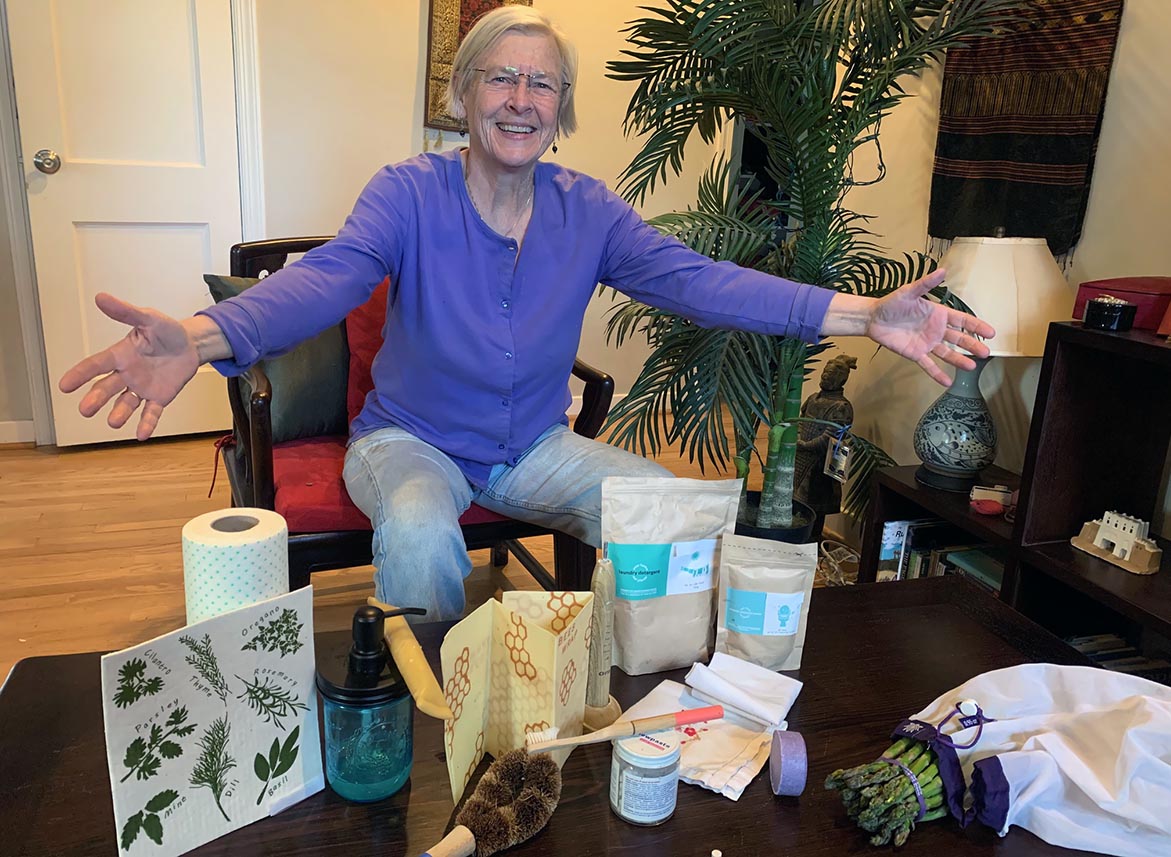U.S. households generated an estimated 51 million tons of plastic waste in 2021, but only 2.4 million tons of this was recycled, according to a recent report by Greenpeace.
As a volunteer CBF Clean Water Captain and tree advocate, I’ve been working for clean water and expanding tree canopy—two vital parts of a healthy environment. At the same time, I realized my spouse and I could do much more to cut waste and help reduce the plastic amassing in our oceans and waterways. So, we set out to shrink our consumption of plastic, as well as paper.
Cutting back on plastic and paper products became a household habit more easily than expected. We wish we had started much sooner!
Our journey began with Bea Johnson’s book, “Zero Waste Home: The Ultimate Guide to Simplifying Your Life by Reducing Your Waste.” She spells out how her family of four cut waste to a tiny amount per year. She dissects the five Rs—refuse, reduce, reuse, recycle, and rot (to which many now add a sixth, repair).

CBF Clean Water Captain Kit Norland displays a variety of products that have reduced her family's use of plastic and paper, including reusable towels, Swedish dishcloths, beeswax food coverings, detergents, scrubbing brushes, toothbrushes and toothpaste, cloth napkins, shampoo bars, and vegetable bags.
Kit Norland
We quickly found non-plastic implements to replace kitchen staples—sponges, detergent, paper towels, dish scrubbers, plastic wrap, and more. The detergent comes in compostable pods you break open and mix with water in a glass jar, while a long-lasting dish scrubber is made of coconut and a wooden handle.
On the paper front, alternatives to jumbo packs of one-use paper towels include reusable towels that are sturdy and just need a rinse between uses, and Swedish dish cloths that absorb more than 15 times their weight in water and come in fun patterns and colors.
When it comes to that perennial plastic wrap, consider instead using specially made beeswax wraps. These come in different sizes and tightly seal food containers. They’re washable and can be used for a year or more.
It’s heartening to see cloth bags being used at grocery stores. Some stores have started providing compostable bags for produce. A step further is to shop with reusable mesh produce bags. If your grocery store doesn’t offer compostable bags for produce, ask the manager to consider it.
As a tree hugger, it pains me to think of all the dinner napkins and boxes of tissues I’ve bought. We’ve substituted cotton napkins and handkerchiefs that last a long time. These go into the laundry and are hung out to dry to minimize our dependence on the energy-guzzling dryer. Another way to save trees is switching to toilet paper made of fast-growing bamboo.
We also reduced plastics from toothpaste tubes and toothbrushes. We now rely on tooth “mints” that come in glass jars. A small jar of “chewpaste” (with or without fluoride) lasts us three months. Bamboo toothbrushes, including an electric version, are durable. We’ve replaced plastic deodorant sticks with an option that comes in a small glass jar that goes in the glass recycling.
We’ve switched from plastic jugs of laundry detergent and toilet bowl cleaner to small packets of efficient cleaning products with few chemicals. We buy laundry detergent sheets packaged in compostable cardboard. The cost per load is equivalent to a container of brand-named detergent. Most importantly, our clothes are just as clean.
Instead of carting home jugs of shampoo, we rely on a compact bar of shampoo that cleans without leaving a film, doesn’t dispense tiny plastics into the drain, and lasts weeks. A dramatic difference in bulk is clear from comparing a big bottle of shampoo and a small shampoo bar that comes in a paper wrapper.
A few years ago, I sheepishly recall, I’d grab the weekly grocery ads to make a list of products to buy in volume. Today, we bring a fraction of plastic and paper into the house, plus find the alternatives more efficient and less polluting.
Containers and packaging are a major source of plastic waste. The Environmental Protection Agency issued data on plastics in municipal solid waste between 1960 and 2018. Unsurprisingly, the container and packaging category had the most plastic waste at over 14.5 million tons in 2018.
There are many bracing statistics that make us want to do more to become a zero-waste home. We want to replace plastics far beyond those used daily—explore green pet care companies, learn about green clothing. The list goes on.
It’s a good time to explore, though, as choices of planet-conscious supplies are proliferating. Thank you to all the companies taking into account that every action, however large or small, impacts our environment. And, at the end of the day, environment is everything.
Where to find alternatives to plastic products
Here are just a few suggestions for finding products like those mentioned in this article, along with other reusable, recyclable, and plastic-free products. This list is by no means exclusive, nor does it represent any endorsement by CBF of specific websites, products, or companies.
- Your local grocery store—more grocery stores are carrying products like bamboo or compostable utensils; stainless steel and silicone straws; reusable silicone bags; and reusable beeswax wraps.
- Etee shopetee.com
- Grove Collaborative grove.com
- Eartheasy eartheasy.com
- ZeroWasteStore zerowastestore.com
Kit Norland is a volunteer CBF Clean Water Captain



